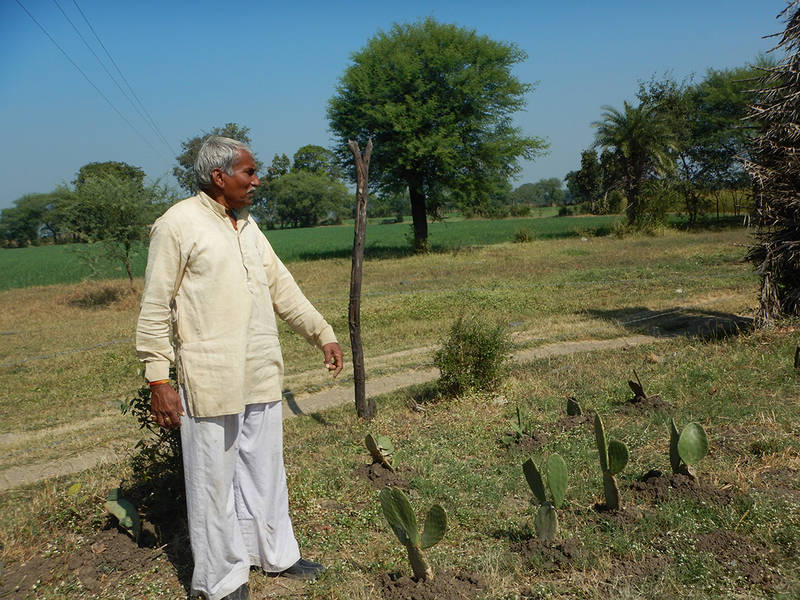Cactus is catching up in India

When 400 farmers – 250 men and 150 women – met in Bhuj in the state of Gujarat in western India earlier this year cactus was high on the agenda. Though still a new crop option for most farmers, this climate resilient plant shows promising signs of becoming an important contributor to regional food and forage security.
“Cactus is a very promising fodder plant, and I would like to cultivate it on at least one acre of land to feed my cows. Besides, I can get better income by also selling cladodes to other farmers,” said Suresh Patel, a farmer from Bhuj, speaking at a two-day field event organized by ICARDA and India’s Central Arid Zone Research Institute (ICAR-CAZRI).
Female farmers also showed interest, suggesting the adoption of cactus for livestock forage could eventually increase milk production. The positive reactions from farmers in Bhuj reinforce the findings of a recently published article in the Journal of Sustainability, titled ‘Adoption and Utilization of Cactus Pear in South Asia—Smallholder Farmers’ Perceptions’.
A new concept
Cactus as a fodder crop can address the widespread shortage of green fodder, particularly during the summer months when high temperatures and water scarcity threaten food security in many parts of the country. Cactus demonstrates great adaptive traits under harsh agro-climatic conditions in many dryland areas, including in large parts of India, and often thrives where no other crops can grow.
Recognizing these benefits ICARDA began to explore the potential of using cactus pear (Opuntia ficus-indica) as a source of fodder in 2013, with support from the Indian Council of Agricultural Research (ICAR), the Ministry of Agriculture, and the Government of India.
Addressing challenges
But there is a long way to go from exploring the potential of these new crops to actually harvesting them and reaping the benefits they provide. Among the initial challenges for resource-poor farmers, for instance, is the need to identify and test varieties that match local needs and conditions.
A four-year pilot project working across five Indian states is testing different cactus varieties in collaboration with decision makers and farmers, including those in Bhuj. The initiative followed an international cactus research meeting held in New Delhi in 2011, when the Director General of ICAR expressed interest in farming spineless cactus for fodder.
The Central Arid Zone Research Institute and the Indian Grassland and Fodder Research Institute (ICAR-IGFRI) subsequently approached the ICARDA-FAO Cactus Network for guidance on how to introduce cactus as a new crop in India, and some 67 cactus varieties from Latin America, Southern Europe, and North Africa were compiled for further testing.
The 67 cactus varieties were used by ICARDA, ICAR institutions, and universities, to develop pilot nurseries in 2014 and 2015, which were established at multiple locations in collaboration with ICAR-IGFRI, ICAR-CAZRI, the Food Legume Research Platform (FLRP), the Bhagalkot University of Horticultural Sciences, and the International Crops Research Institute for the Semi-Arid Tropics (ICRISAT).
Of the 67 varieties, 18 performed well and were deemed suitable for the next phase. Since then, nearly 45,000 cladodes have been distributed among farmers through ICAR institutions and State Departments in the five states of Odisha, Karnataka, Uttar Pradesh, Madhya Pradesh and Gujrat.
Scaling out
Farmers and decision makers in Bhuj, with its large animal population, fodder shortage, and suitability for cactus cultivation, were soon inspired to expand research and development efforts and explore some of the additional uses of cactus. The plant has medicinal properties for instance, and can be consumed as food or used as a source of biofuel.
At the field event earlier this year, Prabhav Joshi, a Chief Development Officer in Bhuj, encouraged farmers to grow cactus for fodder - to not only improve their livelihoods but also to help disseminate the cactus to other farmers in the region where government- and NGO-run cow shelters have increased demand for green fodder.
The Chief Development Officer promised further government support and resources to speed up the process of multiplying cactus cladodes which will now be taken on by the forest department in Bhuj. In parallel, ICARDA and CAZRI are preparing to provide additional training for farmers and technicians on cactus production technology.
For more information about ICARDA’s cactus research activities:
Mounir Louhaichi: [email protected] and Sawsan Hassan: [email protected]
For more about the cactus program in India: Ashutosh Sarker: [email protected]

